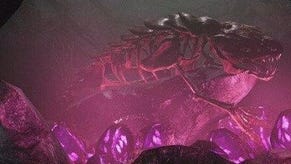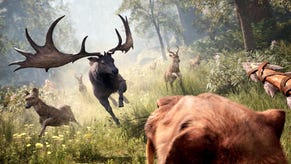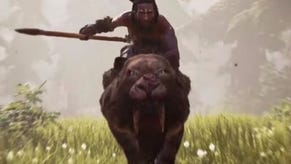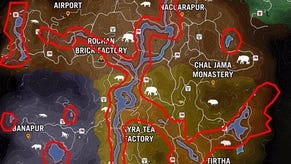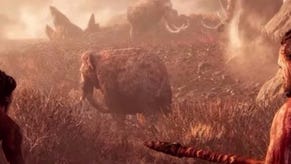Far Cry Primal review
Gotta skin 'em all.
Picture a moment in space and time. It can be anywhere and anywhen. It could be aeons ago, long before the first upwardly mobile fish ever unlocked the ability to walk on land, or it could be a few centuries into the future, during the 31st term of President Trump Al Saud. However far-flung the scenario, frame it in your mind and I'll make you a promise: Ubisoft is there. Ubisoft has always been there. Waiting for you, with a sackful of fast travel points and upgrade materials, pop-up escort missions and fluidly chaining takedowns.
If Far Cry: Primal is proof of anything it's that there is no epoch that can't be translated into the affable lingo of the Ubisoft open worlder, give or take the odd period idiom. The "explore, destroy, colonise" rhythms of previous Far Cries settle into place around this one's Stone Age premise like a white blood cell engulfing an exotic bacterium. What, were you expecting a mere 10,000 years to really change anything, other than the names we give to things like grenades, grappling hooks and throwing knives? Ha ha ha! It is already too late.
A rather downbeat opening, that, for a review of a game I would otherwise deem "fun". But the critical drawback of Primal's dramatic set-change is that the recycled mechanics, narrative beats and themes really do stick in the craw. It's deflating because if you squint, you can just about see the shape of something radical through the tissues of a spin-off seemingly knocked out to hold the fort while Far Cry 5 gestates: a hunting sandbox that mixes Ubisoft Montreal's knack for accessible tactical combat with the stringency of a true-blue survival sim, and which turns Far Cry 3's love affair with clashing AI variables into a game about mastering an ecology.
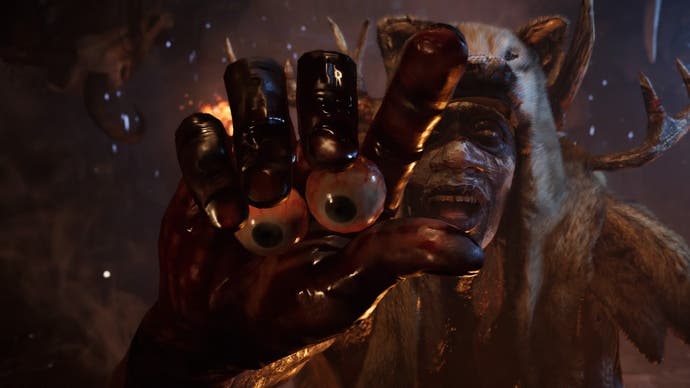
When night falls on the rolling temperate landscape of Oros, wolfpacks can be seen ghosting through distant glades, strafing herds of deer. Bears wrestle over territory. Jaguars are speedy, writhing silhouettes in the tall grass, dangerously easy to miss. Click and hold right stick to activate the obligatory magic vision mode, and you'll see scent trails left by rarer beasts, the creatures whose pelts you need for the choicest caveman apparel, but even without such contrivances, you can make out the eyeshine of an advancing sabretooth, and the blood spatter left by a savaged wild boar. Providing, that is, you don't rush. Ubisoft's open worlds are designed to keep the player in perpetual motion, their emergent quests and oddities forever tugging at your elbow. Constructed as it is around stalking the wildlife, Primal leaves more space for quiet appreciation.
But then you open the inventory screen, and normal service resumes. The world map, undersized by the developer's standards but good for around 20 to 30 hours of play, blooms gradually amid the fog of war as you push out from your base to the east, capturing settlements and bonfires - this year's radio towers - while zeroing in on the endgame missions to north and south. The inventory is a gigantic maw howling to be placated with herbs, wood, leather and rock, such that traversing the undeniably majestic landscape becomes a deadening exercise in jogging from one resource drop to the next.
The skills tree is the same balance of active and passive, from unlocks that double your arrow-crafting capacity or speed up health regeneration, to unlocks that allow you to tag enemies, run while crouched or string together assassinations. All the abilities are as enjoyable to wield as ever - there's nothing I like better than to tail a pair of rival hunters, wait for a lull in the conversation, then spear one guy in the rump and bean his friend with a throwing dart in the same movement. But having to laboriously re-acquire the set for the third time over, a few millennia before the birth of Jason Brody, seems a more than usually sad waste of a timeframe. I'd call it reinventing the wheel, but the wheel hasn't been invented yet.
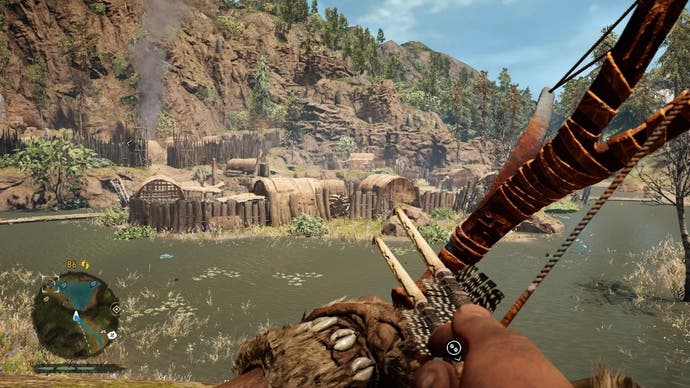
There are, of course, a few new tricks and tools for the pile, chief amongst them the ability to tame animals. But first, the story. Ubisoft has gone to some lengths to weave an authentic script, bringing a pair of linguistics professors on board to craft two distinct languages for Primal's three vaguely North European tribes. You can even buy a phrasebook with certain editions of the game. It's an impressive achievement - and a provocative constraint for a series that goes in for hectic monologues, because what it boils down to is sentences no longer than five words, in which everybody uses the present tense and only a privileged few deploy the definite article.
The first-person cutscenes are executed with their usual, demented vigor - you're continually being grabbed or molested by loudly dressed screwballs and having disgusting objects shoved under your nose - but there's little room for the customary pontificating on morality and politics. It's all "go here, whack this, pick up some resources on the way home", and the plot is equally spartan. Your task as bearded avenger Takkar (voiced, a bit hilariously, by Elias "I didn't ask for this" Toufexis) is simply to found a settlement and nurture it, recruiting villagers via both story and side missions, and getting Neolithic on various warlike neighbours.
It's not a framework that allows for much character development: you start out a tough, capable caveman and end the game a somewhat tougher, more capable caveman with a bigger rucksack. Takkar's impersonality doesn't bother me that much, following Ubisoft Montreal's experiments with Brody and Ajay Ghale, but I wanted to know more about his antagonists, the fire-worshipping Izlia and cannibalistic Udam. They have their reasons for encroaching on your turf, as you'll discover during the inevitable drug-fuelled hallucinatory episodes, but they're extinguished before they have a chance to get interesting.
Another not-quite-developed thread is hunting and taming, though this is definitely the part of Primal that does most to earn the price of admission. It begins with your arsenal, a selection of bows, spears and clubs backed up by throwables such as poisoned darts that send enemies berserk, and pots of bees for use against close-knit groups. The weapons may sound underwhelming on paper but there are a few fun ramifications. One, Takkar can't carry as much ammunition as his predecessors (you only have room for a couple of spears at the outset), so fighting at range is more considered, a real question of picking your moments. Two, bows, spears and clubs have relatively long wind-up and recovery periods, which creates a pleasant amount of stress when taking aim at a charging rhino. And three, all of your primary weapons are flammable. As always in Far Cry, setting an entire village on fire is an elegant and often accidental solution to the problem of dug-in resistance.
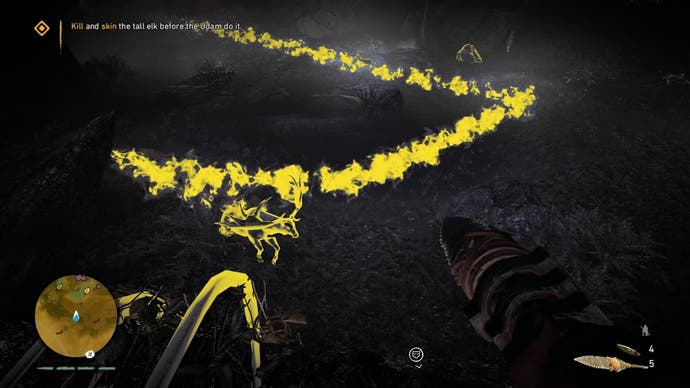
Fire is also used to deter predators, but the safer gambit is to recruit a predator of your own. Taming, Primal's headline mechanic, comes into force early on and is very straightforward. You simply craft and toss a lump of bait before the creature spots you, then approach while it's eating and shush it insistently by holding a button, whereupon the poor thing will obey you till death. My understanding of the science of domestication is crude, but I've seen The Horse Whisperer and this is definitely the streamlined version of that. Still, you can't argue with the result: a powerful and reasonably autonomous AI buddy that can be summoned via the D-pad, almost anywhere in the world, and even revived from the grave using widely available red herbs.
Each flavour of beast has stealth, strength and speed stats, plus a couple of unique abilities. Wolves are for recon, extending your radar out by a few hundred feet. Jaguars are for silent takedowns. Bears draw aggro away from you and dig up resources when not in combat. Badgers are average fighters but also indestructible - send one into an outpost and, given enough patience and yelling, it should take care of everything without you having to lift a finger. Even dead companions have their uses - you can, of course, skin them, typically right under the nose of the latest incarnation.
My personal favourite is Colin the Bloodfang sabretooth tiger. I've been in love with him ever since I bent down to rub his ears and he somehow burst into flame - the mark of a true bond between man and beast, though the burning thatch nearby may have had a part to play. There's also the owl (I call her Mildred), the first creature you'll tame, who can be directed in third-person to recon bases, set targets for other animal companions, and bombard enemies with any throwables you have in your inventory. The AC-130 gunship of her era, in short.
Animal companions are some consolation for the absence of multiplayer of any sort, not that Far Cry multiplayer in general has ever struck me as essential. They also pay into a collection of late-game missions that are, I think, among the best Far Cry has offered, though there's room for improvement. Beast Master hunts see you tracking legendary predators through sealed-off but sizeable areas of the map, wearing them down in combat, then pursuing the creature to its lair and either taming or slaying it. The tracking aspect is quite smoke-and-mirrors - all you're really doing is using Magic Caveman Vision to locate footprints, then following them to a waypoint - but there's enough suspense and uncertainty woven into the process to enthral.
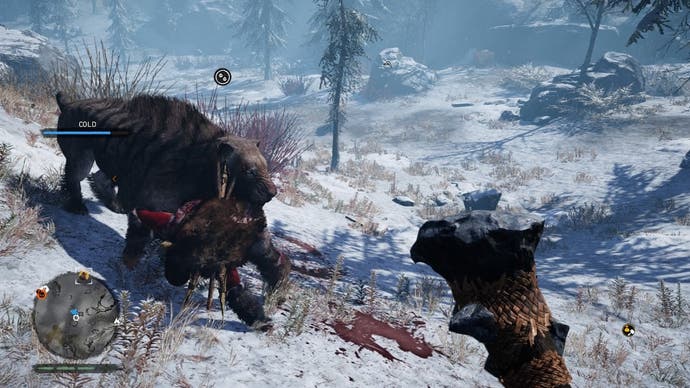
At intervals the trail divides, and you can, I was pleased to discover, uncover it without the HUD's assistance if you're willing to take your time. Once you've entered the animal's vicinity, you can lay traps to harm or immobilise it, though most of my kills came about via the time-honoured mechanism of hurling incendiaries all over and standing on a boulder.
It's certainly a cut above the human-on-human scraps, which feature a familiar assortment of melee fighters, archers, reinforcements callers and juggernauts. To say nothing of the bossfights, in which you claw at enormous health bars while fending off waves of minions and repeatedly reviving your four-legged accomplice. Chin up, Colin! Your umpteenth valiant sacrifice has bought me the few seconds I need to concoct some replacement firebombs. Now if you'd be so good, go jump on the man in the bearskin cloak to stop him dodging around while I aim.
If only the developers had taken this side of things further. As things stand, Primal's endgame feels like it should be the start of a journey away from a formula that is losing its lustre. To paraphrase Bioshock Infinite: there is always a man and there is always a radio tower, or at least an edifice that serves the same function. There is always a main objective you're working your way towards, and a crop of variables or emergent activities that interfere amusingly with your attempts to reach it. There are always pop-eyed nutters in the cinematics, and there is always the faint suspicion that the geography is, in fact, a very picturesque spreadsheet. Primal has moments of verve, and offers many hours of competent, free-roving entertainment, but it's a game from the past in more ways than one.


